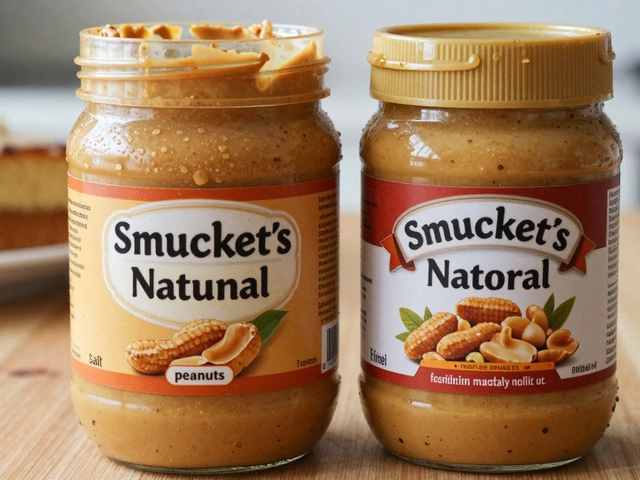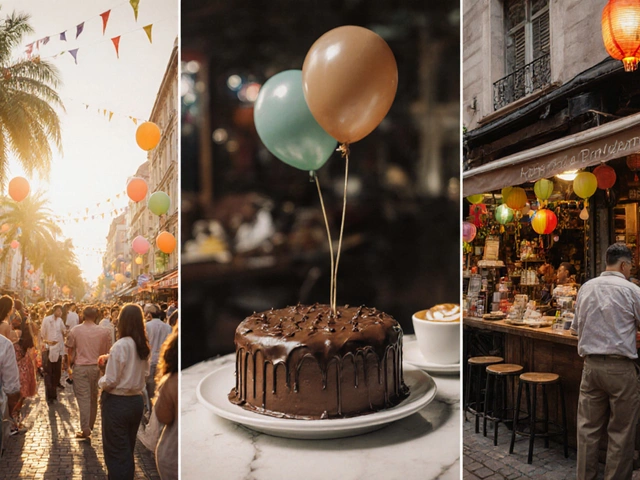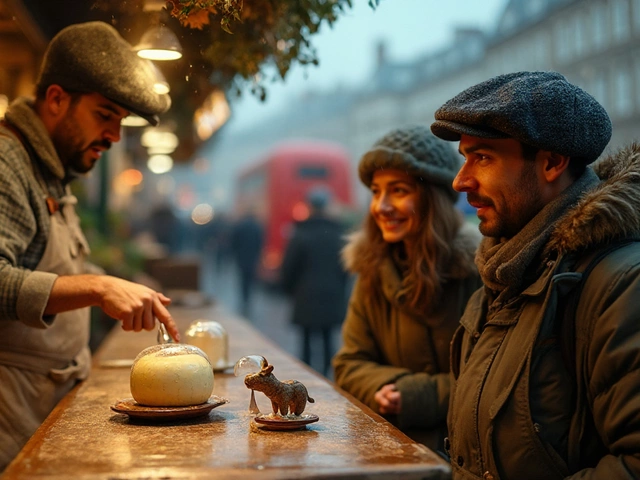Luxury Cake Cost Calculator
Customize Your Luxury Cake
Adjust ingredients to see how your cake would cost based on real luxury bakery pricing.
Cost Breakdown
Top Luxury Cakes Comparison
| Cake | Price | Key Ingredients | Bakery |
|---|---|---|---|
| Louis XIII Truffle Diamond Cake | $500,000 | Edible gold, 24-carat gold leaf, 2 carats pink diamonds | Moore's Confectionery |
| Golden Royal Celebration Cake | $250,000 | 24-carat gold leaf, rare saffron, diamond dust | Carla's Couture Cakes |
| Black Forest Platinum Cake | $120,000 | Platinum foil, black truffle ganache, opal sugar crystals | Heidelberg Pastry House |
When you hear the phrase most expensive cake, you probably picture a towering confection covered in glittering gold leaf and maybe a few sparkling gems. In the United States, the record‑breaking example is the Louis XIII Truffle Diamond Cake - a luxury birthday cake that sold for $500,000 in 2023. This article unpacks why a cake can cost half a million dollars, breaks down the ingredients, and compares it to other ultra‑luxury desserts that have made headlines.
Key Takeaways
- The Louis XIII Truffle Diamond Cake holds the current U.S. record at $500,000.
- Edible gold, 24‑carat gold leaf, rare vanilla beans, and real diamonds drive the price.
- Only a handful of bakeries have the expertise and security clearance to create such cakes.
- Clients commission these cakes for milestone birthdays, corporate galas, and charitable fundraisers.
- A quick comparison shows how the top three most expensive U.S. cakes differ in size, flavor, and embellishment.
Why Do Ultra‑Luxury Cakes Exist?
Luxury cakes are less about eating and more about signaling status. A billionaire turning 100, a tech mogul celebrating a IPO, or a charity auctioning a dessert for a cause - each scenario uses a cake as a centerpiece that tells a story of wealth, taste, and exclusivity. The market isn’t huge, but it’s lucrative for specialist pastry chefs who master rare ingredients and the logistics of handling high‑value décor.
Profile of the Record‑Breaking Cake
The Louis XIII Truffle Diamond Cake was crafted by Moore's Confectionery, a boutique bakery in Manhattan known for custom celebration desserts. Ordered by a Silicon Valley billionaire for his 100th birthday, the cake featured:
- Five layers of white chocolate ganache infused with Madagascar vanilla beans.
- A core of truffle mousse made from rare Peruvian cacao.
- Between‑layer sheets of edible gold (24‑carat) and gold leaf applied by hand.
- Two carats of certified diamonds delicately set into the frosting.
- Custom edible metallic paint that mirrors a private jet’s livery.
The final weight was about 5 kg (11 lb), and the cake stood 12 inches tall - impressive but still manageable for an indoor celebration. Moore's Confectionery shipped it in a climate‑controlled, bullet‑proof crate, complete with a security escort.

Ingredient Deep Dive
Every component of the cake carries a premium price tag:
- Edible Gold: Sourced from a Swiss refinery, 100 g of 24‑carat gold costs roughly $5,800.
- 24‑Carat Gold Leaf: Hand‑laid sheets cost $1,200 per sheet; the cake used 15 sheets.
- White Chocolate: Made from Venezuelan cacao butter, the chocolate alone adds $1,200.
- Madagascar Vanilla Beans: At $600 per kilogram, the cake required two kilograms for its aroma.
- Diamonds: Two carats of ethically sourced pink diamonds contributed $480,000 of the price.
- Truffle Mousse: Incorporates rare Peruvian cacao beans valued at $2,500.
The remaining $8,400 covers labor, design, transportation, insurance, and the bakery’s brand premium.
How Clients Commission a Million‑Dollar Cake
Ordering a cake of this caliber isn’t a walk‑in to a storefront. The process usually looks like this:
- Initial Consultation: The client meets with the pastry chef (often via video) to discuss theme, size, and budget.
- Design Mock‑ups: Sketches, 3‑D renderings, and material samples are provided for approval.
- Ingredient Sourcing: Specialized suppliers are engaged for edible gold, rare spices, and gemstones.
- Production: The bakery’s master patissiers work in a secure, climate‑controlled kitchen for weeks.
- Security & Delivery: Insurance covers the cake’s full value; a security team transports the crate.
- Setup & Service: On‑site technicians apply final touches and ensure safe handling during the event.
Because each step incurs costs, the final price can fluctuate based on flavor complexity, decorative elements, and the client’s timeline.
Comparison of the Top Three Most Expensive U.S. Cakes
| Cake | Price (USD) | Weight | Key Luxury Elements | Bakery |
|---|---|---|---|---|
| Louis XIII Truffle Diamond Cake | $500,000 | 5 kg | Edible gold, 24‑carat gold leaf, 2 carats pink diamonds, Madagascar vanilla | Moore's Confectionery |
| Golden Royal Celebration Cake | $250,000 | 4 kg | 24‑carat gold leaf, rare saffron, hand‑painted enamel, diamond dust | Carla's Couture Cakes |
| Black Forest Platinum Cake | $120,000 | 3 kg | Platinum foil, black truffle ganache, German kirsch, opal sugar crystals | Heidelberg Pastry House |
All three cakes share a common theme: they combine culinary mastery with jewelry‑grade materials. The price gaps mainly reflect the amount and type of precious metals and gemstones used.

Cost Breakdown: Where Does the Money Go?
To demystify the $500,000 figure, here's a simplified ledger for the Louis XIII cake:
| Item | Cost (USD) |
|---|---|
| Edible gold (100 g) | $5,800 |
| Gold leaf (15 sheets) | $18,000 |
| Pink diamonds (2 carats) | $480,000 |
| White chocolate & vanilla | $2,800 |
| Truffle mousse | $2,500 |
| Labor & design | $10,000 |
| Insurance & security | $5,900 |
| Total | $525,000 |
The numbers show that the diamonds dominate the budget, but the specialty ingredients and security overhead are far from trivial.
Why Spend Half a Million on a Cake?
Beyond the obvious “wow” factor, there are three practical reasons buyers invest in such desserts:
- Brand Amplification: Companies use the cake as a PR stunt, gaining media coverage that far exceeds the cost.
- Charitable Fundraisers: Auctioning the cake can raise millions for non‑profits.
- Legacy Creation: For families with generational wealth, a record‑setting cake becomes a historic family anecdote.
In each case, the cake serves as a catalyst for something bigger than the slice itself.
Frequently Asked Questions
What qualifies a cake as "luxury"?
Luxury cakes combine premium culinary techniques with high‑value materials like edible gold, rare spices, or gemstones. The cost of ingredients, craftsmanship, and security all factor in.
Can I order a similar cake for a smaller budget?
Yes. Many bakeries offer "gold‑trimmed" cakes using edible gold leaf instead of solid gold or diamonds. Prices can start around $2,000 for a modestly sized cake.
Are the diamonds on the cake real?
For the Louis XIII cake, the two carats are certified pink diamonds set in a food‑grade, edible lacquer. They are real but not meant to be eaten.
How long does it take to make a $500,000 cake?
From concept to delivery, expect 4-6 weeks. Sourcing rare ingredients and coordinating security adds extra lead time.
Is the cake edible?
Yes, every bite is made from high‑quality ingredients. The only non‑edible parts are the diamonds and the protective crystal case used during transport.
Whether you’re a curious foodie or planning a one‑of‑a‑kind celebration, understanding the components of a $500,000 cake helps you appreciate the blend of art, chemistry, and finance that makes it possible.





